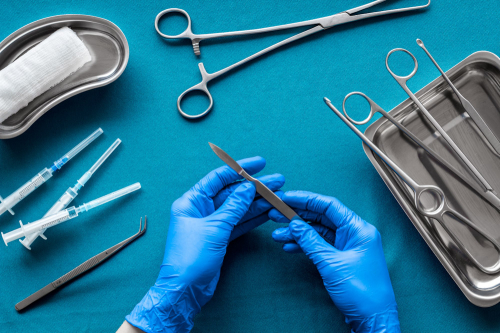- Posted by
Desired outcome
Perforations of the gastrointestinal tract caused by chronic inflammatory diseases like Chron’s disease present a global economic burden. Before defining a future product, an analysis of a competitive landscape is needed to better understand our customer’s needs. We need to identify what solutions are already on the market, their cost, and the effectiveness of treatments so that we can develop a new product for our future customers.
Initial Problem Description
The economic burden of treating peptic ulcer perforation and fistulas is substantial, including medical costs, indirect costs related to productivity losses, and the economic impact on healthcare systems. We’re developing a product to treat perforations that arise due to chronic inflammation and lower the burden on an individual and society. Still, to understand our future customers better, we need to analyse the competitive landscape. To understand the pains and gains of our future customers, we need to analyse what is missing in the market. This way, we can include features to our product to increase its value and align it with the customer’s needs.
Context
Our team is working with mesenchymal stem cells (MSCs), which have great potential to treat different diseases in combination with scaffolds made from different biomaterials. Advanced therapy medicinal products (ATMPs) are medicines based on genes, tissues, or cells, providing new opportunities for treating diseases and injuries. Currently, our team uses the abilities of MSCs to treat orthopaedic injuries and illnesses that include inflammation. These stromal cells can self-renew, show adherence while in vitro, and differentiate into different types of cells. They can be isolated from various tissues, such as bone marrow, adipose, umbilical cord, etc. MSCs have shown great potential due to their immunomodulatory effects and the possibility of using them in tissue engineering and other regenerative treatments.
We have already received input from a surgeon specialist about issues around treating perforations and the need for better solutions on the market. Current approaches, even existing stem cell therapy products, do not account for internal pressure (from other organs, etc.) and inflammation. The active pharmaceutical ingredient can be washed away. We want to understand better the pain and costs that arise from treatments already on the market so we can develop the best product for our future customers, including surgeons, hospitals, and public or private health insurance companies.
Connection to cross-cutting areas
With the development of this product, our company would contribute to more resource-efficient health practices that heal the disease and prevent further complications that contribute to the global economic burden. With fewer surgical and medical interventions, we would contribute to waste reduction, less energy consumption, and carbon footprint.
Input
Inflammatory diseases of the bowel, such as Crohn's disease and ulcerative colitis, can lead to perforation, especially Crohn's, which is characterized by full-thickness inflammation of the bowel wall. Erosive diseases, such as the local invasion of the wall of a viscus by a tumour or ulcerative disease, can also cause perforation. A peptic ulcer is an open sore in the stomach lining or the upper part of the small intestine. Perforation occurs when an ulcer erodes through the wall of the stomach or duodenum, leading to leakage of stomach contents into the abdominal cavity. Treatment typically involves a combination of medical and surgical approaches that may include simple closure of the perforation, patch closure with an omental flap, or more extensive surgery, depending on the severity of the perforation and the patient's condition. Omental patches may provide a temporary seal over the perforation. Still, they may not address the underlying causes of the ulcer, such as Helicobacter pylori infection or long-term use of nonsteroidal anti-inflammatory drugs (NSAIDs). This means that while the patch may close the perforation, it does not prevent the recurrence of ulcers.
Expectations
We look to identify an ideal customer or customer to be considered, such as a profile of a surgeon, hospital management, and insurance company. We expect defined needs of the respective customer profile, how they are currently addressing the issue, their "job to be done," and what pains and gains arise from treatments already existing on the market. We would like to see a collection of different methods used in surgery, effectiveness, and problems that can arise during or after treatment. If data is available, we would also like the costs of each treatment and pricing strategies.
Desired Team Profile
Interest in pharma and business development will help to deliver the solution. The medical background would help understand the indications and quicken the search for the answer by assisting teammates in finding problems with current treatments. A wide range of knowledge is needed to solve this challenge.
Additional Information
To help the selected team promptly deliver results, one team member of Animacel will be designated for this project on our side so that communication can be quick and efficient through the platform. If any questions arise, an assigned person will guide you while searching for the solution. We're happy to collaborate.
Related Keywords
About
Animacel was established as a spin-out company of the Veterinary Faculty in Ljubljana in 2011 due to a revolutionary technology based on cutting-edge science in the stem cell therapy area. The academic knowledge we acquired during several years of research was brought into clinical veterinary medicine to help dogs and horses with joint, sinew, and ligament problems. Stem cell therapy has great potential to advance veterinary and human medicine.

You need to sign up to apply to this challenge and submit a motivation letter!

Learn more about the topics and find team members!
Help
Need help submitting your proposal or have questions regarding this Open Innovation Challenge?
Contact support

